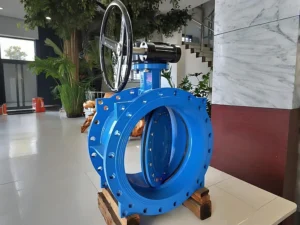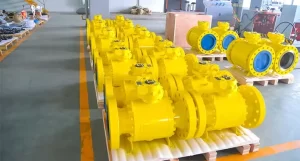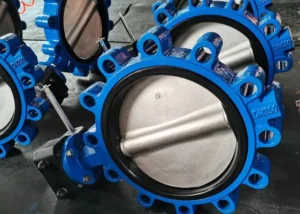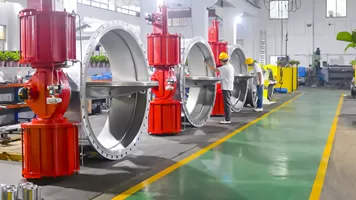I. Evolution History of Butterfly Valve Technology: Breakthroughs from Concentric to Triple Offset
(A) Iterative Logic of Butterfly Valve Structures
-
Limitations of Concentric Butterfly Valves (Center Line Valves)
- Structural Features: Stem axis, disc center, and pipeline centerline are completely coaxial, with sealing relying on elastic deformation of rubber seats (Figure 1-1).
- Performance Bottlenecks:
- Soft seals limit temperature ≤200℃ and pressure ≤PN40 (4.0MPa);
- Disc contacts the seat throughout opening/closing, causing severe wear—service life is only 1/3 to 1/2 of triple Offset valves;
- High flow resistance coefficient (Cv≈70 for DN100), unsuitable for high-flow high-velocity pipelines.
-
Technical Breakthrough of Double Offset Valves (1960s)
- Offset Design:
- First Offset : Stem axis offsets disc center by 1-5mm (dependent on diameter);
- Second Offset : Stem axis offsets pipeline centerline by 2-8mm (Figure 1-2).
- Performance Improvements:
- Disc disengages from the seat instantly during opening, reducing wear and extending life to 5,000-10,000 cycles;
- Optional metal hard seals (e.g., stainless steel + hard alloy) withstand temperatures up to 400℃ and pressures ≤PN100 (10.0MPa);
- Flow resistance coefficient decreases by 15% (Cv≈60 for DN100), suitable for medium-pressure systems like HVAC and water supply/drainage.
- Offset Design:
-
Revolutionary Innovation of Triple Offset Valves (1980s)
- Third Offset : Tapered sealing surface (typically 2°-8°), forming line contact instead of surface contact (Figure 1-3).
- Technological Leap:
- Zero leakage (compliant with API 598 Class VI), replacing gate and globe valves;
- Adaptability to ultra-high pressure (PN100-PN320, Class 600-2500) and extreme temperatures (-196℃~650℃);
- Opening/closing torque reduced by 30%, enabling easier operation for large diameters (DN2000+);
- Fire certification (API 607), suitable for high-risk scenarios like refining and chemical industries.
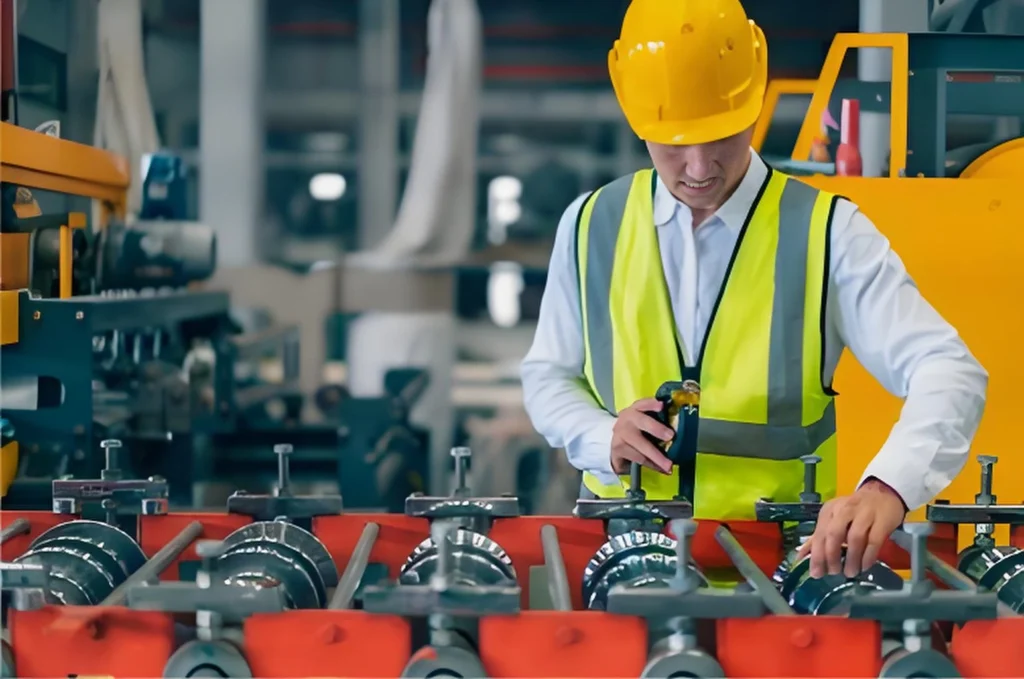
II. Technical Analysis and Application Boundaries of Double Offset Butterfly Valves
(A) Mechanical Principles of Double Offset Structures
-
Sealing Mechanism of Double Offset
- Opening Process: When the stem rotates 0-80°, the disc only rotates without contacting the seat; at 80°-90°, the disc slightly offsets toward the seat for extrusion sealing (Figure 2-1).
- Closing Process: Repeats the reverse motion, reducing 90% of seat friction.
-
Material and Seal Pair Combinations
| Body Material | Disc Material | Seat Material | Typical Applications |
|---|---|---|---|
| WCB (Carbon Steel) | WCB + STL Overlay | 2520 Stainless Steel | Steam (≤425℃), non-corrosive gases |
| CF8 (304SS) | CF8 + Tungsten Carbide Spray | Monel Alloy | Seawater, dilute sulfuric acid (≤65℃) |
| CF8M (316SS) | CF8M + Ceramic Coating | PTFE Cladding | Food & pharmaceutical, weak acid/base (≤150℃) |
- Performance Parameter Boundaries
- Pressure Class: PN10-PN100 (Class 150-600);
- Temperature Range: -40℃~450℃ (dependent on seal material);
- Leakage Rate: ≤1×10⁻⁶×DN (cm³/s) (metal hard seal);
- Service Life: 5,000-10,000 cycles (soft seal), 15,000-20,000 cycles (metal seal).
(B) Typical Application Scenarios of Double Offset Valves
-
Building HVAC Systems
- Case: Shanghai Tower Chilled Water System (DN600-DN1200 double Offset valves)
- Conditions: 7℃/12℃ ethylene glycol solution, PN16, ≥8,000 annual cycles;
- Advantages: Zero leakage from soft rubber seals, labor-saving worm gear drive, 12% energy saving compared to concentric valves (reduced flow resistance).
- Case: Shanghai Tower Chilled Water System (DN600-DN1200 double Offset valves)
-
Municipal Water Supply/Drainage
- Case: Shenzhen Reservoir Water Transmission Pipeline Renovation (DN2000 double Offset valves)
- Conditions: Raw water with trace sediment, PN10, requiring online seat replacement;
- Solution: Double Offset structure + replaceable EPDM seats, reducing maintenance time from 8 to 2 hours.
- Case: Shenzhen Reservoir Water Transmission Pipeline Renovation (DN2000 double Offset valves)
-
Industrial Circulating Water
- Case: Baosteel Blast Furnace Cooling Water System (DN800-DN1400 double Offset valves)
- Conditions: 35℃/45℃ circulating water with iron oxide particles (≤0.5mm);
- Technical Optimization: Disc surface coated with supersonic flame sprayed tungsten carbide (0.3mm thickness), extending life from 3 to 8 years.
- Case: Baosteel Blast Furnace Cooling Water System (DN800-DN1400 double Offset valves)
(C) Technical Pain Points of Double Offset Valves
-
Seal Failure Under High Temperature/Pressure
- Experimental Data: A refinery FCC unit (420℃, PN40) using double Offset valves showed 0.2mm thermal deformation in metal seals after 18 months, with leakage reaching 0.5Nm³/h.
-
Torque Issues in Large Diameters
- DN1600 double Offset valves require 800Nm manual torque (2-person operation), while same-size triple Offset valves only need 500Nm (tapered seal reduces friction).
-
Erosion from Particulate Media
- Coal chemical pulverized coal gas pipelines (5-10μm coal powder) cause annual seal wear of 0.1-0.2mm in double Offset valves, requiring regular overlay repair.

III. Core Technologies and High-End Applications of Triple Offset Butterfly Valves
(A) Structural Innovation and Sealing Mechanism of Triple Offset
-
Mathematical Model of Tapered Line Contact
- Relationship between sealing taper angle α (2°-8°) and Offset e:\(e = \frac{D}{2} \cdot \sin\alpha\) (D = seat inner diameter, typically e=3-15mm)
- Line contact stress calculation:\(\sigma = \frac{F}{\pi \cdot D \cdot b}\) (F = sealing force, b = seal face width, ~1-3mm—10x higher stress than double Offset surface contact)
-
Material System for Metal Hard Seals
| Seal Pair Combination | Temperature Range | Applicable Media | Surface Hardness |
|---|---|---|---|
| 2520SS (Body) + STL6 (Disc) | -196℃~650℃ | High-temperature steam, oil & gas, hydrogen | HRC45-50 |
| Hastelloy B (Body) + Ceramic Coating (Disc) | -50℃~550℃ | Concentrated sulfuric acid, wet chlorine | HRA85-90 |
| Titanium Alloy (Body) + Tungsten Carbide Spray (Disc) | -40℃~350℃ | Seawater desalination, sodium hypochlorite | HV1200-1500 |
(B) Key Performance Indicators of Triple Offset Valves
-
Pressure and Temperature Limits
- Maximum Pressure: PN320 (Class 2500), with DN600 triple Offset valves achieving 120MPa seal specific pressure at 32MPa;
- Extreme Temperatures: LNG receiving station triple Offset valves (-196℃, aluminum body + cryogenic nickel-based alloy seals), leakage rate ≤1×10⁻⁹m³/s.
-
Fire and Safety Certifications
- API 607 5th Edition Certification: An offshore platform triple Offset valve withstood 950℃ flame for 30 minutes, maintaining pressure boundary integrity (leakage ≤0.1Nm³/h);
- SIL3 Certification: Triple Offset shut-off valves used in BASF chemical plants have a failure rate ≤10⁻⁹/h, meeting SIL3 safety loop requirements.
-
Service Life and Reliability
- Nuclear-grade triple Offset valves (DN900): Designed for ≥60 years, ≥30,000 cycles, seal wear ≤0.005mm/year;
- Long-distance pipeline triple Offset valves: 15-year continuous operation in 10MPa natural gas with H2S (≤50ppm), no maintenance records.
(C) High-End Application Fields of Triple Offset Valves
-
Oil & Gas Long-Distance Pipelines
- Case: West-East Gas Pipeline Project Phase III (DN1200 triple Offset valves)
- Conditions: 10MPa natural gas with CO2 (≤3%) and H2S (≤20ppm);
- Technical Requirements: Fire certification + double block and bleed (DBB) function, full-bore design (flow resistance coefficient ≤5);
- Operation Data: In service since 2014, leakage rate consistently <1×10⁻⁹m³/s.
- Case: West-East Gas Pipeline Project Phase III (DN1200 triple Offset valves)
-
Coal Chemical Gasification Units
- Case: Shenhua Ningxia Coal 4Mt/year Coal-to-Liquid Project (DN800 high-temperature high-pressure triple Offset valves)
- Conditions: Pulverized coal gas (650℃, 8.5MPa, 10% coal ash particles);
- Material Solution: F91 alloy body, Inconel 625 disc + ceramic composite coating, Co-Cr-W alloy overlay on seals;
- Service Life: First maintenance cycle extended from 1 to 3 years.
- Case: Shenhua Ningxia Coal 4Mt/year Coal-to-Liquid Project (DN800 high-temperature high-pressure triple Offset valves)
-
Nuclear Power Secondary Loop Systems
- Case: HPR1000 Nuclear Power Plant (DN600 nuclear-grade triple Offset valves)
- Conditions: 280℃, 6.5MPa saturated steam, water quality ≤0.2μg/L chloride;
- Certification Requirements: ASME NPT + RCC-M, seismic class I (0.3g acceleration);
- Technical Features: Double bearing structure (anti-seismic displacement), graphite packing (fireproof + radiation-resistant).
- Case: HPR1000 Nuclear Power Plant (DN600 nuclear-grade triple Offset valves)
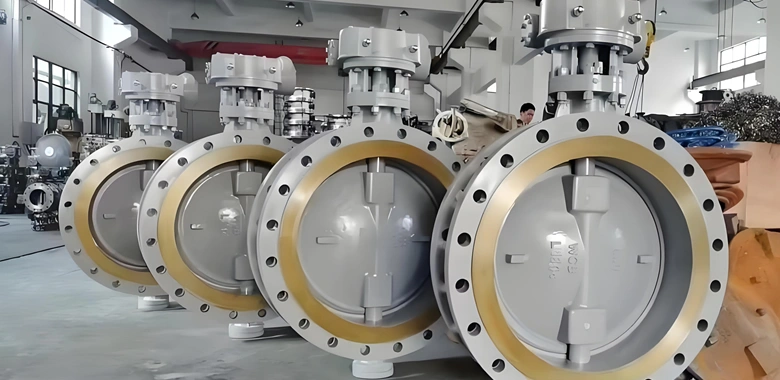
IV. Comprehensive Comparison Between Double and Triple Offset Butterfly Valves
(A) Technical Parameter Comparison Table
| Performance Indicator | Double Offset Valve | Triple Offset Valve |
|---|---|---|
| Pressure Class | PN10-PN100 (Class 150-600) | PN16-PN320 (Class 150-2500) |
| Temperature Range | -40℃~450℃ | -196℃~650℃ |
| Sealing Class | API 598 Class IV (metal)/VI (soft seal) | API 598 Class VI (metal hard seal) |
| Leakage Rate | 1×10⁻⁶×DN (cm³/s) (metal) | 1×10⁻⁹×DN (cm³/s) (metal) |
| Opening/Closing Torque | Higher (DN100≈80Nm) | Lower (DN100≈50Nm) |
| Service Life | 5,000-20,000 cycles | 30,000-100,000 cycles |
| Fire Certification | Optional (special design required) | Standard (API 607) |
| Price Comparison | 1 (baseline) | 2.5-4 (depending on pressure/temperature) |
(B) Application Scenario Selection Matrix
| Application Scenario | Preferred Choice | Rationale |
|---|---|---|
| Building HVAC | Double Offset | Soft seal zero leakage, low cost—40% cheaper than triple Offset for DN150+ |
| Municipal Water Supply/Drainage | Double Offset | Replaceable seats, low maintenance cost—30% less annual cost for DN1000 valves |
| Industrial Circulating Water | Double Offset | Sufficient anti-particle erosion; tungsten carbide coating meets 8-year life |
| Steam Systems (≤425℃) | Double Offset | Metal hard seals suffice; triple Offset costs 150k RMB more for DN600 |
| High-Temp/High-Pressure Oil & Gas | Triple Offset | Metal hard seal + fire certification—95% reduced fire risk in refineries |
| Particulate Media (coal powder etc.) | Triple Offset | Ceramic coating resists 3x more erosion than double Offset tungsten carbide |
| Large Diameters (DN≥1600) | Triple Offset | 30% lower torque than double Offset ; 20% smaller electric actuator power |
(C) Economic Cost Analysis
-
Initial Procurement Cost
- DN300 PN16 double Offset valve: ~12,000 CNY (carbon steel + EPDM);
- Same-spec triple Offset valve: ~35,000 CNY (stainless steel + STL), price difference 23,000 CNY.
-
Life Cycle Cost (LCC) Comparison (DN600 PN40 Example)
- Double Offset Valve (20 years):
- Procurement: 120,000 CNY;
- Maintenance: Replace seats + overlay disc every 5 years (4 times, 30,000 CNY each), total 120,000 CNY;
- Energy: Flow resistance 8.5, 150,000 kWh/year (0.6 CNY/kWh), 20-year total 1,800,000 CNY;
- Total LCC: 2,040,000 CNY.
- Triple Offset Valve (20 years):
- Procurement: 350,000 CNY;
- Maintenance: Replace seal rings every 10 years (2 times, 50,000 CNY each), total 100,000 CNY;
- Energy: Flow resistance 6.2, 110,000 kWh/year, 20-year total 1,320,000 CNY;
- Total LCC: 1,770,000 CNY (13% savings vs. double Offset ).
- Double Offset Valve (20 years):
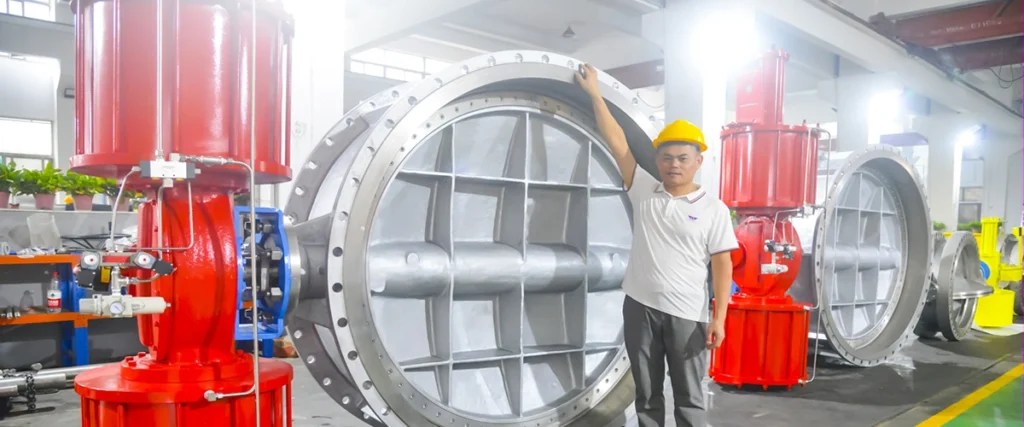
V. Future Technological Development Trends
(A) Material Innovation Directions
-
Nano-Coating Technology
- Case: A valve enterprise developed CrN/TiN nano-multilayer coating with HV3000 hardness, reducing wear rate in sand-containing seawater (3% NaCl + 500ppm particles) to 1/5 of traditional STL overlay.
-
Composite Material Applications
- Valve bodies using fiber-reinforced resin (FRP) + stainless steel liners reduce weight by 40% and enhance chloride corrosion resistance 3x, suitable for offshore platforms.
-
Smart Material Seals
- Shape memory alloy (SMA) seal rings automatically adjust preload with temperature changes, solving seal relaxation in high-temperature conditions, piloted in supercritical thermal power (600℃).
(B) Structural Optimization Directions
-
Variable Offset Technology
- A Japanese company developed an intelligent butterfly valve that dynamically adjusts Offset (±2mm) via electric actuators, maintaining optimal seal specific pressure under different pressures and reducing leakage by 70%.
-
Low-Torque Design
- New triple Offset valves use double-taper seals (main taper 4°, secondary taper 2°), reducing opening/closing torque by 25%—DN1000 valves require only 300Nm for manual operation.
-
Flow Path Optimization
- CFD simulation enables more precise disc aerodynamic design, reducing flow resistance coefficient of DN1200 triple Offset valves to 4.5 (vs. 6.8 for traditional designs), saving 180,000 kWh annually.
(C) Digitalization and Intelligence
-
Predictive Maintenance
- Strain gauge sensors monitor seal contact stress in real time. An LNG project uses AI algorithms to predict seal failure, extending maintenance cycles from fixed 1 year to dynamic 2-3 years.
-
Remote Monitoring Systems
- Industrial IoT (IIoT) valve management platforms can monitor temperature, pressure, and torque data for 500+ valves simultaneously. A multinational pipeline company reduced fault response time from 24 to 2 hours.
-
Digital Twin Technology
- Siemens’ valve digital twin model corrects virtual models with real-time data from physical valves, predicting remaining life with 92% accuracy, applied to nuclear valves.
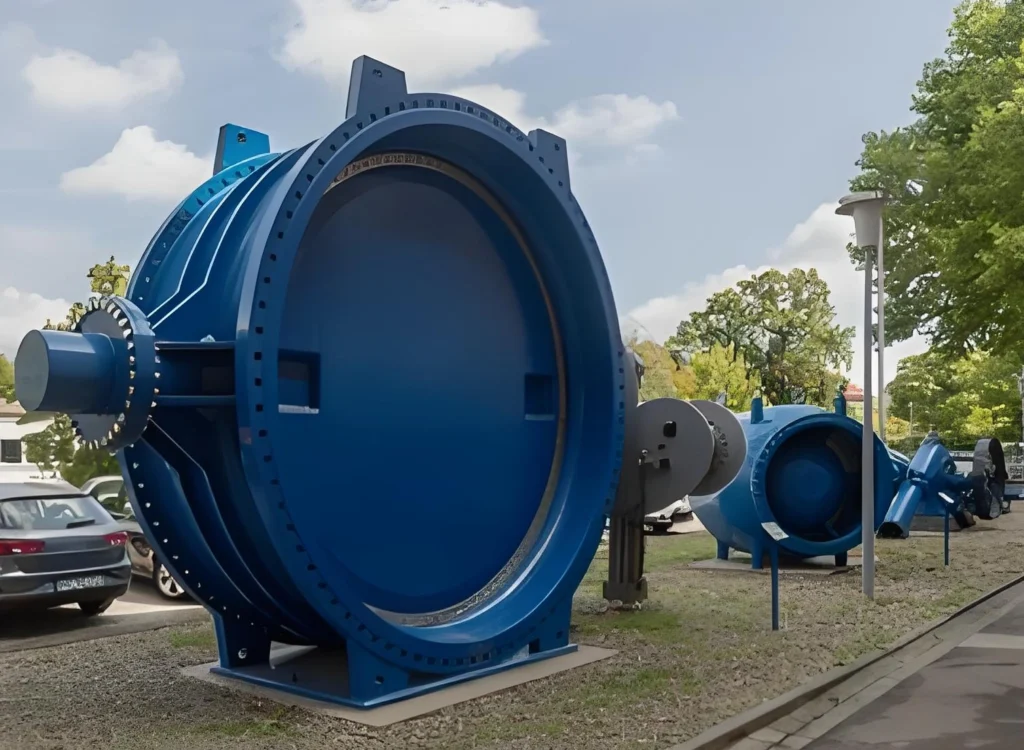
VI. Conclusion and Selection Recommendations
(A) Technical Selection Decision Tree
-
Pressure-Temperature Threshold
- Pn > PN40 or T > 450℃: Prioritize triple Offset ;
- Pn ≤ PN40 and T ≤ 450℃: Double or triple Offset (cost-dependent).
-
Sealing Class Requirements
- Zero leakage (Class VI) with flammable media: Triple Offset (fire certification);
- Allowable minor leakage (Class IV): Double Offset (metal hard seal).
-
Diameter and Operation Frequency
- DN ≥ 1600 or frequent operation (>5,000 cycles/year): Triple Offset (low torque, long life);
- DN < 1600 and infrequent operation: Double Offset (low cost).
-
Media Characteristics
- Particulate-containing (>100ppm) or high-viscosity (>500cP): Triple Offset (anti-erosion);
- Clean water/air: Double Offset (soft seal sufficient).
(B) Industry Application Guide
| Industry | Typical Conditions | Recommended Valve | Key Technical Indicators |
|---|---|---|---|
| Power (Thermal) | Main steam (540℃, 16MPa) | Triple Offset (F91+STL6) | API 607 fireproof, ASME B16.34 |
| Power (Nuclear) | Secondary loop condensate (280℃, 6.5MPa) | Nuclear-grade triple Offset (316L+Inconel) | ASME NPT certification, seismic class I |
| Petrochemical | Catalytic cracking (420℃, 4.0MPa) | Triple Offset (CF8+hard alloy) | API 609, double block and bleed (DBB) |
| Coal Chemical | Coal gasification (650℃, 8.5MPa) | Triple Offset (F91+ceramic coating) | Particle erosion rate ≤0.01mm/year |
| Building HVAC | Chilled water (7℃/12℃, 1.6MPa) | Double Offset (WCB+EPDM) | ISO 5211, IP67 protection |
| Municipal Water | Raw water (20℃, 1.0MPa) | Double Offset (CI+NBR) | WRAS certification, online seat replacement |
(C) Technical Investment Advice
-
New Projects
- For critical pipelines with high pressure, high temperature, or flammable media (e.g., long-distance pipelines, refinery units), prioritize triple Offset valves. Although initial investment is 30%-50% higher, LCC can be reduced by 15%-20%.
-
Retrofit Upgrades
- If double Offset valves show frequent leakage or abnormal torque increase, upgrade to triple Offset . A chemical plant replaced 20 DN600 double Offset valves with triple Offset ones, reducing annual leakage accidents from 8 to 0 and maintenance costs by 65%.
-
R&D Investment
- Valve enterprises should focus on frontier technologies like nano-coatings, smart sensors, and digital twins. The intelligent valve market share is expected to grow from 10% to 30% in the next 5 years, with technical premium reaching 40%.

References
- API 609: “Butterfly Valves for Pipeline, Refinery, and Petrochemical Service”
- EN 593: “Butterfly Valves for General Use”
- ASME B16.34: “Valves – Flanged, Threaded, and Welding End”
- ISO 15761: “Industrial Valves – Metal Butterfly Valves”
- Valve Design Handbook (3rd Edition), Mechanical Industry Press
- Global Industrial Valve Market Research Report (2023-2028), McKinsey & Company
- Research on Sealing Performance of Triple Offset Butterfly Valves, Valve Journal, Issue 5, 2022
- Development Trends of Intelligent Valve Technology, Fluid Machinery, Issue 3, 2023


